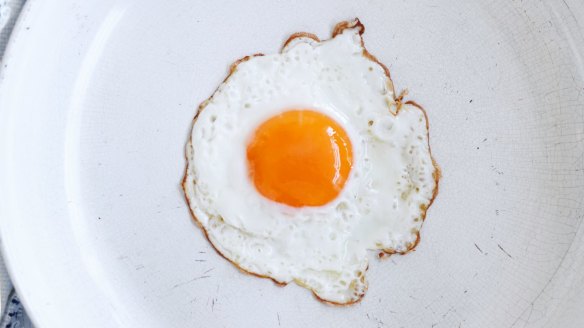Why some food sticks to pans and how to prevent it

Raise your hand if you've ever burned eggs on the bottom of your frying pan. Now that it's clear that we're among friends, take comfort in knowing this fact: It's not all your fault.
It's science we have to blame. Partially, anyway.
Let's start with those eggs. "Most pans, even the really good ones, are actually filled with little cracks and crevices," says Joseph Provost, a chemistry and biochemistry professor at the University of San Diego who co-wrote The Science of Cooking: Understanding the Biology and Chemistry Behind Food and Cooking.
When the pan is heated, the metal expands, allowing the egg to get trapped in those microscopic cracks, where it then sticks and burns.
Eggs actually have two things working against them: Their liquid flows into those cracks, and their proteins are problematic.
As Harold McGee explains in Keys to Good Cooking: A Guide to Making the Best of Foods and Recipes, "High heat causes food proteins and carbohydrates to form bonds with the pan surface." And according to the Royal Society of Chemistry, "protein-rich foods are particularly prone to sticking because the proteins can form complexes with metal atoms, such as iron, in the pan."
See, it's not just you. Sticking is particularly problematic when it comes to delicate foods such as eggs and fish, McGee writes.
But it's just as annoying with sturdier pieces of meat, too. Chicken and lean beef are prone to sticking because they're high in protein but low in fat, Provost says. Without much fat to lubricate the surface between the pan and the food, the meat will stick.
Here are a few things you can do about that.
Place a barrier between the food and the pan
The most obvious is to put a barrier between what you're cooking and the surface of the pan. You can use some kind of cooking fat, such as butter or oil.
Provost recommends heating the pan first. Then add the fat and let it get hot, but not so hot that it burns. (For eggs, McGee says butter is better than oil, as butter "carries anti-sticking emulsifiers.")
Surface sticking points
Another barrier is air. "Sticking is reduced on grill-like, dimpled and irregular pan surfaces that reduce direct contact between food and pan," McGee says. However, "They also reduce browning and flavour development."
If you're using a well-seasoned cast-iron pan, then you have built-in protection. When you cook in cast iron, the heated fats reorganise into a plastic-like coating that bonds to the pan.
Or you could go with manufactured nonstick cookware, whose coating smooths out the surface of the metal and separates it from the food.
Sear the meat quickly...
Since the goal is to start breaking down the proteins on the surface of the meat as quickly as possible – before they can start bonding with the metal – any heat and time lost in cooking off that moisture is working against you. Plus, browning means flavour, so it's better to be searing than steaming when it comes to meat.
McGee says that coating food in flour or breadcrumbs can prevent sticking. That outer layer is both a barrier and method for further creating a dry surface.
A key point is to make sure you leave your meat in the pan long enough, Provost says. If you try to remove it too soon, it will stick.
The browning is what will help the meat release itself from the pan, once the proteins are broken down sufficiently. (Sometimes a little sticking is good, as when you get the cooked-on juices, or fond, that you can incorporate into a pan sauce.)
It's also essential to pat your meat dry before you place it in the pan. Otherwise, the heat in the pan will evaporate the water on the surface rather than brown the meat.
... but have patience
Contrary to what you might think, patience, rather than speed, is crucial to avoiding food that sticks.
In other words, it's best to put the time in up front – rather than scraping all that burnt-on food out of the pan later.
The Washington Post
The best recipes from Australia's leading chefs straight to your inbox.
Sign up- More:
- How to